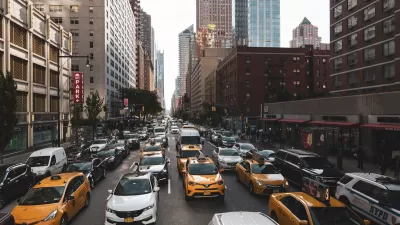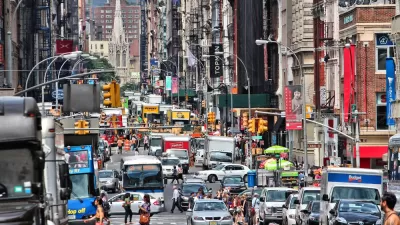After more than a decade of delays and reversals, congestion pricing is expected to take effect in Manhattan in late 2023 or early 2024.

The New York MTA earlier this week released the Environmental Assessment for the long-awaited congestion pricing scheme proposed for a section of Manhattan, reports Stephen Nessen for Gothamist.
The Central Business District Tolling Program Environmental Assessment (EA), which is available for public review, includes new details about how congestion pricing—more accurately described as cordon pricing—will work in Manhattan. “The congestion pricing assessment considered a range of tolling schemes for vehicles, including one that charged as little as $9 during peak hours,” explains Nessen. The high end of the range for private automobile owners could go to $23. “The tolls for commercial vehicles and trucks range from $12 to $82,” reports Nessen.
As for the other end of the equation, the congestion program is expected to raise $1 billion for improvements to public transit.
About 80% of the money raised would go toward subways and buses, with 10% to the Long Island Rail Road and 10% to Metro-North. The current capital plan stands at up to $56 billion, and revenue from the proposed congestion pricing plan would cover 30% of it. The MTA hopes to invest the $1 billion and generate $15 billion in total.
More background on the long road to this point for congestion pricing in New York City are included in the source article below, in addition to some discussion about the potential impact of congestion pricing on the public realm in the nation’s most populous city.
FULL STORY: MTA releases congestion pricing details, with fees that could be as high as $23 for drivers

Planetizen Federal Action Tracker
A weekly monitor of how Trump’s orders and actions are impacting planners and planning in America.

Chicago’s Ghost Rails
Just beneath the surface of the modern city lie the remnants of its expansive early 20th-century streetcar system.

San Antonio and Austin are Fusing Into one Massive Megaregion
The region spanning the two central Texas cities is growing fast, posing challenges for local infrastructure and water supplies.

Since Zion's Shuttles Went Electric “The Smog is Gone”
Visitors to Zion National Park can enjoy the canyon via the nation’s first fully electric park shuttle system.

Trump Distributing DOT Safety Funds at 1/10 Rate of Biden
Funds for Safe Streets and other transportation safety and equity programs are being held up by administrative reviews and conflicts with the Trump administration’s priorities.

German Cities Subsidize Taxis for Women Amid Wave of Violence
Free or low-cost taxi rides can help women navigate cities more safely, but critics say the programs don't address the root causes of violence against women.
Urban Design for Planners 1: Software Tools
This six-course series explores essential urban design concepts using open source software and equips planners with the tools they need to participate fully in the urban design process.
Planning for Universal Design
Learn the tools for implementing Universal Design in planning regulations.
planning NEXT
Appalachian Highlands Housing Partners
Mpact (founded as Rail~Volution)
City of Camden Redevelopment Agency
City of Astoria
City of Portland
City of Laramie





























